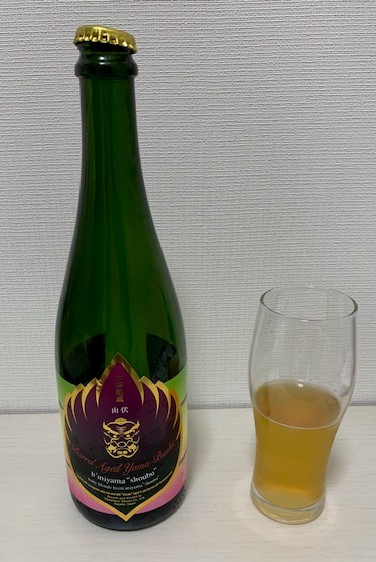
We don’t use the word “unique” too often around here, and we are not prone to hyperbole, unless we are talking about our own accomplishments, of course, but this week we are going to use the word quite a bit. The beverage under review is Yamabushi, which translates as “mountain priest.” The name suggests a bit of rusticity, and there are elements of that to be sure. The brew is unfiltered and is, as might be expected, a little cloudy. There is nothing especially unusual about that at a time when many producers are making natural wine. Indeed, from its appearance alone—the metal crown, the cloudy pale yellow liquid with a bit of fizz—Yamabushi could easily pass as a pet-nat. But this is no impostor! Tamamura Honten Co. Ltd., a Nagano-based firm, has delivered the real McCoy, and it’s a genuine gem.
The label says in English that it is “brewed with homegrown sake rice,” and by that we assume that they mean it is rice grown in Nagano Prefecture. Okay, that’s good but not unique, is it? But wait a minute, it also says that “wild shoubu” has been added. We suspect that many of our readers might not be familiar with this plant, so a little explanation is in order. The Latin name for this is Acorus calamus, but the most common name in English is “sweet flag.” The sweetness of the sweet flag comes through loud and clear on the Yamabushi nose. On the palate the sweetness of the plant is offset by a degree of sourness.

So what is sweet flag, anyway? We first encountered this semi-aquatic plant in a Japanese-style bath on Boys’ Day (now Children’s Day), a holiday during Golden Week. The fragrance arising from the hot water is sweet, pleasant, and soothing. In other countries and at other times this plant has been used for a wide variety of purposes. Three examples—one geographical and two historical—will have to suffice here. In France “[s]weet flag…has been used in beers, to scent the snuff a’ la violette, and as an addition to some perfumes.”1 The ancient Greeks and Romans valued it as a medicine, and in the early days of the United States it was sometimes prepared as a confection. Yamabushi is unique!
Hold on, there’s more here. Yamabushi is aged in oak barrels. Now that is not something you encounter every day, is it? Unique!
And those oak barrels contain Brettanomyces, a kind of yeast. To some, it is an unwelcome guest, to others it is a valued visitor. Robinson et al. put it thus: “While it is widely considered a spoilage yeast since it can produce off-flavours in wines, there are producers who suggest that at low levels some of the diverse flavours produced by Brettanomyces can improve red wine complexity. …In some beers, for example Belgium’s spontaneously fermented lambic and gueuze beers, Brettanomyces and its effects are essential….”2 And Yamabushi does bear a certain resemblance to lambic. Nevertheless, it is UNIQUE!
This mountain priest weighs in at 6.5% abv.
1Motley, T. “The Ethnobotany of Sweet Flag,” Economic Botany, Vol. 48, No. 4.
2 Robinson, J. et al., The Oxford Companion to Wine (Oxford: Oxford University Press, 2015).